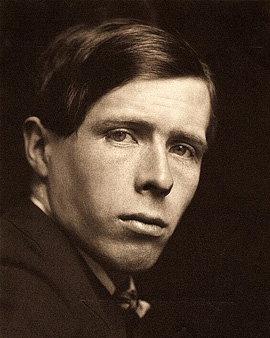The work of the Irish painter William Orpen is dominated by two subjects, the portrait and war paintings. In both, he achieved great popularity as an official chronicler in the service of the British government and military leadership. This already addresses an outstanding characteristic of the person and the artist. Throughout his life he was an advocate of a fervent British nationalism. Although Orpen was born in Ireland, he stands for the division of the country into a Catholic majority and a Protestant and British-oriented elite of the country. As the son of a lawyer, he was brought up in the corps spirit of a military-oriented mentality. The Irish Easter Rising of the Catholics and Irish nationalists in 1916 shook Orpen to such an extent that he left his homeland forever and never set foot on Irish soil again. As a result, his project of a cultural rebirth of Ireland based on a British identity also failed. His artistic creations during the Irish Renaissance, however, remained of considerable influence for the Irish artists of the next generation, for example Sean Keating. His teaching position at the Metropolitan School of Art in Dublin, which he gave up in 1914, also contributed to this.
The outbreak of the First World War removed Orpen from his Irish mission and gave his nationalism an artistic goal. Orpen, after volunteering for military service in 1914, joined the War Artist Project of the British War Propaganda Offices in 1916 and devoted himself entirely to the goal of a British victory over the German Empire. An action by the artist at the beginning of the war shows here his nationalist orientation. Orpen sold empty canvases to rich citizens for the benefit of the British Red Cross and the care of war wounded, on which portraits were later to be painted. He began his artistic propaganda activities with a popular caricature with the descriptive title "Kaiser Wilhelm II as the Devil".
After first making portraits of soldiers, he travelled to the Western Front in 1917 and recorded the material battles in the trenches there. Among his most famous paintings are "Dead German soldiers in a trench" and the "Tank", a painting in which a British tank drives over German barricades and buries a trench underneath it.
After the end of the war Orpen received military awards and was accepted into the Royal Academy of Arts. The British military leadership commanded Orpen to be the official portrait artist at the Versailles peace negotiations. Among other things, he recorded the signing of the Versailles Treaty in the Hall of Mirrors in the castle and painted it. However, the artist caused a scandal with a war painting during an exhibition at the Royal Academy in 1923. Under the title "The Unknown British Soldier in France" Orpen exhibited a composition that provoked the moral sentiment of the time. Next to a coffin covered with the Union Jack, two British soldiers were placed on guard of honour with bare torso. After protests in the press and a statement from the War Department, the artist redesigned his painting.
×





.jpg)
.jpg)
 - (MeisterDrucke-302516).jpg)
 - (MeisterDrucke-302516).jpg)
.jpg)
.jpg)
.jpg)
.jpg)
.jpg)
.jpg)
.jpg)
.jpg)
_-_(MeisterDrucke-904544).jpg)
_-_(MeisterDrucke-904544).jpg)
.jpg)
.jpg)
.jpg)
.jpg)
.jpg)
.jpg)
.jpg)
.jpg)
.jpg)
.jpg)
.jpg)
.jpg)
.jpg)
.jpg)
.jpg)
.jpg)
.jpg)
.jpg)
.jpg)
.jpg)
_-_(MeisterDrucke-1655061).jpg)
_-_(MeisterDrucke-1655061).jpg)
.jpg)
.jpg)
.jpg)
.jpg)
 - (MeisterDrucke-277470).jpg)
 - (MeisterDrucke-277470).jpg)
.jpg)
.jpg)
 - (MeisterDrucke-158987).jpg)
 - (MeisterDrucke-158987).jpg)
.jpg)
.jpg)
.jpg)
.jpg)
.jpg)
.jpg)
.jpg)
.jpg)
 - (MeisterDrucke-18886).jpg)
 - (MeisterDrucke-18886).jpg)
_(pastel_and_black_crayon)_-_(MeisterDrucke-1315704).jpg)
_(pastel_and_black_crayon)_-_(MeisterDrucke-1315704).jpg)
.jpg)
.jpg)
.jpg)
.jpg)
.jpg)
.jpg)
.jpg)
.jpg)
.jpg)
.jpg)
.jpg)
.jpg)
.jpg)
.jpg)
_-_(MeisterDrucke-1106296).jpg)
_-_(MeisterDrucke-1106296).jpg)
 - (MeisterDrucke-172654).jpg)
 - (MeisterDrucke-172654).jpg)
_-_(MeisterDrucke-1129853).jpg)
_-_(MeisterDrucke-1129853).jpg)
_-_(MeisterDrucke-951348).jpg)
_-_(MeisterDrucke-951348).jpg)
_-_(MeisterDrucke-904272).jpg)
_-_(MeisterDrucke-904272).jpg)
.jpg)
.jpg)
.jpg)
.jpg)
.jpg)
.jpg)
.jpg)
.jpg)
.jpg)
.jpg)
.jpg)
.jpg)
.jpg)
.jpg)
.jpg)
.jpg)
.jpg)
.jpg)
.jpg)
.jpg)
.jpg)
.jpg)
.jpg)
.jpg)
 - (MeisterDrucke-182275).jpg)
 - (MeisterDrucke-182275).jpg)
.jpg)
.jpg)
.jpg)
.jpg)
.jpg)
.jpg)
 c1918 - (MeisterDrucke-161317).jpg)
 c1918 - (MeisterDrucke-161317).jpg)
_c1900_(oil_on_canvas)_-_(MeisterDrucke-1507030).jpg)
_c1900_(oil_on_canvas)_-_(MeisterDrucke-1507030).jpg)
_c1913_(watercolor_over_pencil_on_paper)_-_(MeisterDrucke-1132553).jpg)
_c1913_(watercolor_over_pencil_on_paper)_-_(MeisterDrucke-1132553).jpg)
.jpg)
.jpg)
.jpg)
.jpg)
.jpg)
.jpg)
_-_(MeisterDrucke-1121838).jpg)
_-_(MeisterDrucke-1121838).jpg)
.jpg)
.jpg)
.jpg)
.jpg)
.jpg)
.jpg)
.jpg)
.jpg)
.jpg)
.jpg)
.jpg)
.jpg)
.jpg)
.jpg)
_-_(MeisterDrucke-904062).jpg)
_-_(MeisterDrucke-904062).jpg)
.jpg)
.jpg)
.jpg)
.jpg)
.jpg)
.jpg)
.jpg)
.jpg)
.jpg)
.jpg)
_-_(MeisterDrucke-1129468).jpg)
_-_(MeisterDrucke-1129468).jpg)
.jpg)
.jpg)
_-_(MeisterDrucke-53434).jpg)
_-_(MeisterDrucke-53434).jpg)
.jpg)
.jpg)
.jpg)
.jpg)
.jpg)
.jpg)
.jpg)
.jpg)
.jpg)
.jpg)
.jpg)
.jpg)
.jpg)
.jpg)
.jpg)
.jpg)
_-_(MeisterDrucke-1099811).jpg)
_-_(MeisterDrucke-1099811).jpg)
_(1881-1953)_1899_(red_pencil_on_pap_-_(MeisterDrucke-1099884).jpg)
_(1881-1953)_1899_(red_pencil_on_pap_-_(MeisterDrucke-1099884).jpg)
_-_(MeisterDrucke-1099782).jpg)
_-_(MeisterDrucke-1099782).jpg)
 - (MeisterDrucke-227832).jpg)
 - (MeisterDrucke-227832).jpg)
_-_(MeisterDrucke-1128936).jpg)
_-_(MeisterDrucke-1128936).jpg)
_-_(MeisterDrucke-1633735).jpg)
_-_(MeisterDrucke-1633735).jpg)
_-_(MeisterDrucke-902545).jpg)
_-_(MeisterDrucke-902545).jpg)
.jpg)
.jpg)
.jpg)
.jpg)
.jpg)
.jpg)
.jpg)
.jpg)
.jpg)
.jpg)






